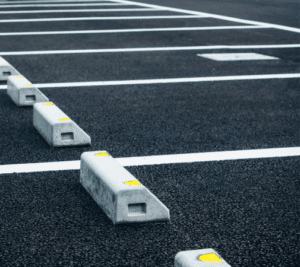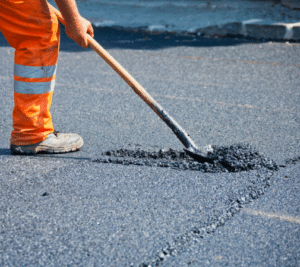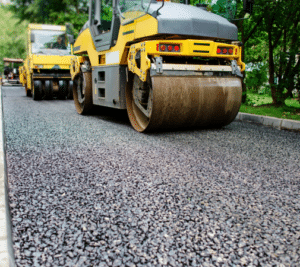What is Asphalt Raveling?
Asphalt raveling is a common problem that surfaces on asphalt pavements. It occurs when the surface of the pavement wears and tears, resulting in the loss of bond between the aggregate particles and the asphalt binder. The problem is usually characterized by the appearance of loose gravel and coarse particles on the pavement’s surface. It is a significant concern because it can lead to the formation of longitudinal and interconnected cracks, which can pose safety hazards for vehicular traffic. This blog post will discuss the causes of asphalt raveling and the various asphalt repair options available.
What Causes Raveling?
Asphalt raveling is a common problem that occurs in asphalt pavements. It refers to the crumbling or breaking off of small aggregate particles from the surface of the asphalt. At first, these small particles may not seem like a significant problem, but raveling can cause the surface to deteriorate over time, leaving behind a rough and uneven pavement.
Several factors can cause asphalt raveling. Let’s look at a few of the most common culprits:
Low-Quality Materials: One of the main culprits is using low-quality asphalt binder. If the asphalt binder is not of sufficient quality, it can break down more easily over time, leading to raveling.
Inadequate Compaction During The Installation Process: If the asphalt is not compacted correctly, it can leave behind small voids and air pockets in the pavement, accumulating loose debris and the breakdown of the aggregate matrix. Additionally, heavy traffic can also contribute to raveling. The constant movement of vehicles can cause the asphalt to break down and disintegrate, particularly if there is a high traffic volume on the pavement.
Weather: The weather can also play a significant role in the development of asphalt raveling. The asphalt can contract and expand when exposed to temperature extremes, such as cold temperatures. This can cause cracks to form in the pavement, which can ultimately lead to raveling. Exposure to UV rays and moisture can also cause the binder to break down more quickly, leading to the early onset of raveling.
In conclusion, asphalt raveling can be attributed to various factors, including poor quality materials, inadequate compaction, heavy traffic, and weather effects. It is essential to address these issues promptly to prevent pavement deterioration and avoid costly repairs. If you notice raveling or other forms of damage to your asphalt surface, it is essential to contact a professional asphalt repair service to assess the situation and provide appropriate recommendations for repair.
What To Do About Asphalt Raveling?
1. Repair cracks and potholes: One of the most important steps in addressing asphalt raveling is to repair any existing cracks or potholes. This will reduce further pavement deterioration and help protect it from future damage.
2. Sealcoat the surface: Applying a sealcoat can also help to protect the pavement from debris, moisture, and UV rays that can cause further deterioration and raveling.
3. Add a top layer of asphalt: Adding a new layer of asphalt on top of the existing pavement is another effective method for repairing raveling. This will help to fill in any existing cracks or voids and provide a fresh surface that is better able to withstand weather and heavy traffic.
4. Re-compact the asphalt: If raveling is caused by inadequate compaction during installation, it may be necessary to re-compact the asphalt. This involves using a specialized machine to press down and compact the existing surface to fill any air pockets or voids in the pavement.
5. Repair drainage issues: It is also important to address any drainage issues that may be contributing to raveling. This can include the installation of catch basins or French drains and ensuring that the pavement is properly sloped to allow for adequate water drainage.
How to Prevent Asphalt Raveling?
Asphalt raveling can be a major issue for pavement surfaces, causing significant damage that can be costly to repair. However, with the proper preventative measures in place, you can minimize the risk of raveling and extend your pavement surface’s life. Here are some tips on how to prevent asphalt raveling:
1. Proper Compaction
One of the leading causes of asphalt raveling is inadequate compaction when the pavement surface is initially installed. To prevent raveling from occurring, it’s crucial to ensure that the asphalt mix is appropriately compacted during installation. This requires specialized equipment and skilled professionals who understand how to achieve the right level of compaction to prevent raveling.
2. Adequate Binder Content
The binder is an essential component of the asphalt mix, helping to hold the aggregate particles together. If the binder content is too low, the asphalt mix may not adhere properly, leading to raveling. To prevent this, it’s essential to use an asphalt mix with adequate binder content and ensure it is appropriately designed and mixed.
3. Use of Proper Aggregate Particle Size
The size of the aggregate particles used in the asphalt mix can also affect the risk of raveling. Coarse particles can cause the mixture to become unstable and more prone to raveling. You can reduce the risk of raveling by using smaller aggregate particles with a more uniform shape and size.
4. Avoid Heavy Traffic
Pavement surfaces subjected to heavy traffic are at a higher risk of raveling. This is because vehicles’ constant weight and pressure can cause the asphalt to break down and become unstable over time. To prevent raveling, it’s essential to route heavy traffic away from areas where the pavement surface is installed.
5. Regular Maintenance
Regular maintenance is key to preventing asphalt raveling from occurring. This includes keeping the surface clean and free of loose debris and dust coatings and repairing any cracks, potholes, or other damage as soon as it is detected. By keeping the surface in good condition, you can minimize the risk of raveling and extend the life of your pavement surface.
Following these preventative measures can reduce the risk of asphalt raveling and ensure that your pavement surface remains stable and durable for years. If you notice signs of raveling, taking action quickly is important to prevent the damage from worsening. With the right approach to prevention and repair, you can keep your pavement surface in excellent condition and avoid costly repairs.
At Saguaro Asphalt, we understand how important it is to keep your pavement in good condition and prevent asphalt raveling from occurring. That’s why we offer comprehensive asphalt repair services that can address any drainage issues, compact the asphalt mix properly, and ensure that the binder content is adequate for a long-lasting solution. If you’re noticing signs of asphalt raveling on your pavement surface, don’t hesitate to give us a call today and let us help get your pavement back into top shape!



